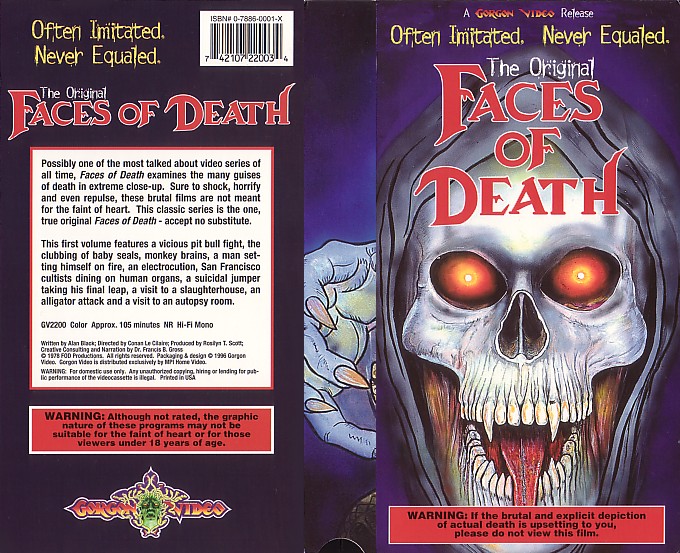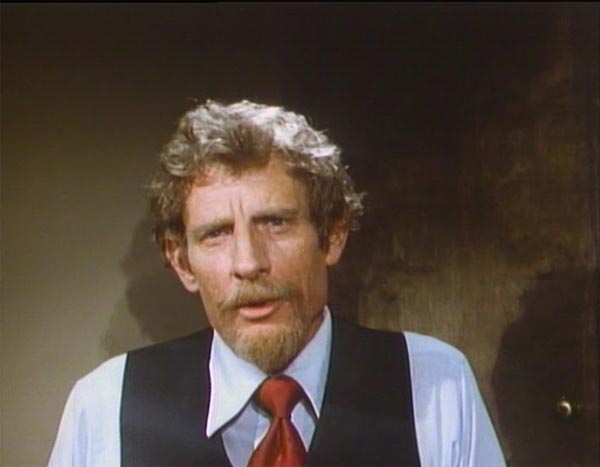Forums
Horror Movie Reviews
Stare Deep Into the Eyes of the "Faces of Death" (1978) - A Glimpse Into Real-Life Horror

Walking through my local video store’s epic horror section some time ago, fting through the most offbeat titles and cover art, there’s always those few that stand out from the rest. Thoroughly inspecting a worn VHS jacket that had seen better days, I instantly noticed superior to its title a bold slogan that stated, “banned in 46 countries,” and a warning label that summed up to manifesting actual depictions of death.
Evidently, as intriguing the box art was, I had to view and learn more about this controveral documentary. Of course, viewing this film back then, being much younger and naïve compared to this present day, my perspective had taken a complete 180-degree turn from having the feeling of nausea set in to becoming fascinated by the medical aspect and taking an up-close look into a society that most civilians had never seen before.
Taking a trip into the depths of Faces of Death (1978) (later titled “The Original Faces of Death” as many imitators ensued) gives the viewer a first-hand perspective into the graphic, but serious, nature of how the culprit of death takes the life of man and animal alike.

Writer and director John Alan Schwartz, who had used multiple pseudonyms such as Conan Le Cilaire and Alan Black to credit himself, dug deep into researching various instances of death, some of which are actual footage of newsreels, as well as on-te filming where the F.O.D. crew risked capturing death up close and personal. This eccentric journey begins by manifesting footage of actual cardiac surgery, which instantly sets the tone for its realism. But it’s up to the viewer to determine what is deemed a reenactment and what the face of death actually looks like in any given scenario.
We are quickly met by the film’s narrator Dr. Francis B. Gross (Michael Carr) who guides the viewer through this epic rollercoaster of emotions and thoroughly explains each sequence, as well as sharing his personal sentiments at times. Carr radiates a sense of seriousness and calming in his voice (not that his phycal look does the same) by kicking things off with how the dead are perceived in foreign cultures. A montage of mummified bodies fill the screen, not necessarily to scare the viewer, but to express how Western civilization differs in the emotional handling of the afterlife contrary to those overseas.

Schwartz and company quickly trantion to the death of man’s fellow specie: the animal. From the melancholy sense of seal clubbing that is difficult to watch to the illegal “sport” of dog fighting where pit bulls are bred to fight to their death only for man’s pity profit. One sequence that stands out is the beheading of a rooster down on the farm. As the muc cheerfully sounds the notes of “Old McDonald” in a posble attempt to ease the viewer’s unsettled cognitions, the camera captures the decapitation of a rooster that will soon be poultry on the dinner table. Following a quick swing of the axe, the bird’s nervous system is sparked by this rapid method of death as it remained fluttering headless for several seconds before it finally shut down for all eternity.
A vit to a slaughterhouse is the next stop as the crew captures the inght of how society’s popular demand for meat makes it from farm to fork. Viewers get to observe the entire process of how the meat industry prepares its product. From the “humane” method of stunning and slaughtering cattle and sheep to the finished product of a thick porterhouse, would the population tend to enjoy their succulent dere if they realized what actually happens inde the blood-stained walls?
As most of the animal sequences are indeed actual depictions of death, one segment that is ealy determined as a mulation, as Schwartz even admitted in an interview presented as a special feature within the DVD edition, is the infamous monkey brain-munching scene. As this is an actual practice in Southeast Aa, certain restaurants give its diners an opportunity to “become closer to God” by eating the brain of a monkey (yes, becoming closer to God is their perception). After the men at the table beat the animal with mallets to its final second of life, the waiter exposes the brain and a platter of brains tar-tar is served. Schwartz also proceeded that the brains inde the fake monkey head were made from cauliflower and gelatin that probably tasted worse than the actual brains served in Southeast Aa.


Sticking with the subject of mulated segments, the politically controveral styles of humane executions are dissected. Inmates on death row accept their fate by methods of the gas chamber and electrocution, which are presented as quite accurate reproductions. In the interview feature, when asked if these execution scenes are legitimate, Schwartz only replies stating that it is illegal to film an event of capital punishment. Following that response, the answer is quite evident of the aforementioned question.
Schwartz even makes a few cameo appearances throughout, one of which is the leader of a flesh-eating cult feasting on the organs of a cadaver and engaging in a blood-laden orgy. But authentic footage is not scarce. Schwartz provides clips of the actual suicide of Mary Ellen Brighton who jumped to her death from a high-rise, and the unfortunate drowning of a young man who had a bit too much to drink. Schwartz also highlights the tragedy of the Holocaust during World War II, as well as a cryogenic procedure in an effort to preserve a man’s body.

More of the medical aspect is observed with a brief interview of a Los Angeles County morgue pathologist Dr. Thomas Noguchi. Viewings of autopes of some of the most grotesque corpses are performed, ranging from homicide to burn victims. But to a medical examiner, it’s another day on the job and the notion of being surrounded by death becomes customary.
Overall, Faces of Death takes a 105-minute journey into the depths of how one meets his own fate. Whether the on-screen imagery ckens, offends or fascinates you, no matter your perception, death is a grim reality that all must come face-to-face with at some point in life.

buried13
Wednesday 12/14/2011 at 04:58 PM | 88260
I remember seeing this a long time ago on VHS. For some reason I can deal with watching dead human bodies... But the animal deaths depicted in this completely disturbed me. That poor monkey... >_< And I don't know why they had to show the slaughter house. Couldn't eat steak or burgers for over a year after witnesng that lol.
Jonny Sicko
Thursday 12/15/2011 at 12:33 AM | 88267
nce when have humans as a society found it okay to watch another humans death, but find it disturbing to see an animal die. This makes no damn sense to me.
haloboyvash
Thursday 12/15/2011 at 10:14 AM | 88287
nce when have humans as a society found it okay to watch another humans death, but find it disturbing to see an animal die. This makes no damn sense to me.
Well, I can't contradict your argument because it's quite valid. I can only rationalize my own. When you see it in the news every day, see it in the streets, hear about it on the radio, watch movie after movie in which the viewer is almost cheering on the villains and looking forward to more creative/inventive kill scenes, your question becomes self-answering. If I were a psychologist, I might theorize that I associate death on film with all deaths on film, real or otherwise due to over saturation of constant stimuli. And I guess a "cop out" counter-argument would be as follows: Either humans should know better, or just look at history. We've been killing each other for thousands upon thousands of years. You might even go as far as stating we as a society are better at corrupting our youth and killing ourselves than anything else; through either random/intentional violent acts or plain stupidity.
Animals kill to survive. We kill because we're fucked up in so many documented and undocumented ways, we can't even begin to categorize them fully yet.
In that sense, animal abuse for the sake of cheap thrills fundamentally disturbs me.
Well, I can't contradict your argument because it's quite valid. I can only rationalize my own. When you see it in the news every day, see it in the streets, hear about it on the radio, watch movie after movie in which the viewer is almost cheering on the villains and looking forward to more creative/inventive kill scenes, your question becomes self-answering. If I were a psychologist, I might theorize that I associate death on film with all deaths on film, real or otherwise due to over saturation of constant stimuli. And I guess a "cop out" counter-argument would be as follows: Either humans should know better, or just look at history. We've been killing each other for thousands upon thousands of years. You might even go as far as stating we as a society are better at corrupting our youth and killing ourselves than anything else; through either random/intentional violent acts or plain stupidity.
Animals kill to survive. We kill because we're fucked up in so many documented and undocumented ways, we can't even begin to categorize them fully yet.
In that sense, animal abuse for the sake of cheap thrills fundamentally disturbs me.
Jonny Sicko
Sunday 12/18/2011 at 02:29 AM | 88398
In that sense, animal abuse for the sake of cheap thrills fundamentally disturbs me.
Now that makes sense to me.
I agree with you entirely on that point. Sorry if I came off sounding a bit harsh, not that I hate animals or anything it just sometimes strikes me when I see people find it more startling to see an animal die compared to a human being. But I totally get what you mean now and I hope you didn't feel I was trying to bash you or call you out. If an any way my post made you feel that way then I ncerely apologize.
It was pretty early in the morning and at that time I tend to let my fingers type what my mind thinks lol. Thanks tho for replying and helping me get a better understanding.
Now that makes sense to me.
I agree with you entirely on that point. Sorry if I came off sounding a bit harsh, not that I hate animals or anything it just sometimes strikes me when I see people find it more startling to see an animal die compared to a human being. But I totally get what you mean now and I hope you didn't feel I was trying to bash you or call you out. If an any way my post made you feel that way then I ncerely apologize.
It was pretty early in the morning and at that time I tend to let my fingers type what my mind thinks lol. Thanks tho for replying and helping me get a better understanding.
haloboyvash
Thursday 12/22/2011 at 10:34 AM | 88542
